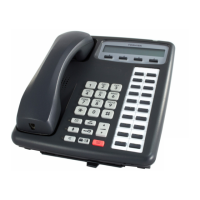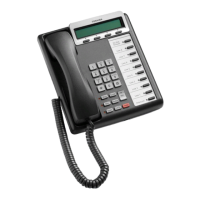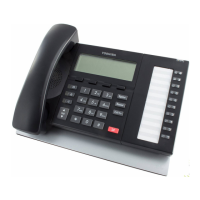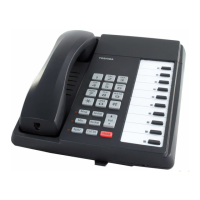Auto Attendant
Peripheral Installation
Strata DK40 I&M Manual Spring 1999
6-51
Refer to the Strata DK40 Programming Manual or DK Library CD-Rom for more details.
associated with a number, such as 3 for Sales, 4 for Customer Service, etc. Callers pick the
destination just by dialling the single number associated with it. The call is then transferred to
the station. Callers can also dial the intercom number directly.
This feature is available from three separate sources.
◆ Strata DK40 built-in Auto Attendant
◆ Voice Mail device Auto Attendant
◆ External Auto Attendant
Strata DK40 Built-In Auto Attendant (AA)
A built-in Auto Attendant feature is programmed into the Strata DK40 system software. To
enable the built-in AA to function, a K5RCU DTMF tone receiver and KKYS/RKYS PCB
must be installed. (see Chapter 4 – DK40 Universal Slot PCB Wiring and Chapter 2 – DK40
Installation for K5RCU and RKYS installation instructions).
The customer must provide digital announcement device(s), on which the greeting and menu
that the callers hear are recorded. The digital announcement devices must connect to Strata
DK standard telephone circuits. There is a series of programs (explained later) in the Strata
DK40 Programming Manual Record Sheets, which are for the built-in AA feature
exclusively, not the other two AA feature applications. Callers must use a DTMF (tone)
telephone to select AA dialling options.
The built-in AA feature offers flexibility in answering calls. Calls follow the basic sequences
described below and illustrated in Figure 6-27.
Sequence A
The call is answered directly after being transferred from the Auto Attendant. The caller calls
in on Exchange lines assigned for built-in Auto Attendant, receives a greeting along with a
menu of dialling options, and then dials an option or the intercom number. The call is then
transferred to a station, which answers the call.
Sequence B
The call is not answered after being transferred from the Auto Attendant and is routed to an
optional secondary announcement, where it will receive a new announcement and the same or
additional dialling options. Some customers may not configure their AA system with a
secondary announcement; if so, their unanswered calls would follow sequence C or D.
Sequence C
The call is not answered after being transferred from the Auto Attendant and is routed to an
alternate station(s) assigned in system programming, ringing assignments.
Sequence D
The call is not answered after being transferred from the Auto Attendant and is routed back to
the primary announcement. This is probably the least desirable of the four sequences, since
the caller hears a repeat of the announcement he just received seconds earlier.
Note
In all of the above sequences, the call can first ring telephones selected in system
programming for 12 or 24 seconds, and then be routed to the Auto Attendant if not
answered by any of the ringing stations. This is called Auto Attendant delayed ring.

